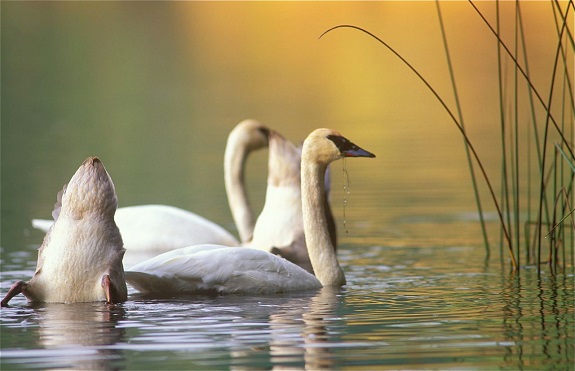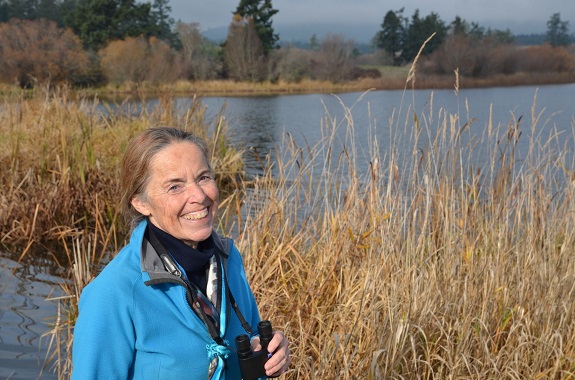If you sleep with your windows open, you may have noticed the morning songs of passerines (songbirds) gradually diminishing, until one morning in November—bam, the sound of honking cries penetrates your half-awake psyche! These new vocalizations are an indication that North America’s largest waterfowl, the Trumpeter Swans (Cygnus buccinator) are returning to their wintering grounds. The San Juan Islands are a refuge from the freezing weather that pushes Trumpeters out of their summer nesting sites in Alaska, more than 2,000 miles to the north. As November turns to December, more will arrive in this region, splashing and bobbing in undisturbed wetlands, lakes, and other bodies of water.

Trumpeter Swans on Zylstra Lake. Photo Credit: Kurt Thorson
Trumpeter Swans were not always a seasonal marker here on the islands, or anywhere for that matter. In 1935, only 69 individuals were counted in their total population, and the Trumpeters’ call seemed destined to be quieted forever. But their numbers have been steadily increasing ever since, due to a combination of protection from hunting and human disturbance, the benefits of habitat conservation, and range-expansion programs. The Washington Department of Fish and Wildlife (WDFW) still tracks the population, continuing to document this remarkable conservation success story.
With the help of volunteers, Preservation Trust Stewardship Manager Kathleen Foley Lewis arranges the swan count throughout the San Juan archipelago and reports back to WDFW annually.
Ties that Bind
There is another remarkable, though little-known, tie between Trumpeter Swans and the Preservation Trust . . .
For most of us, a sense of wonder and joy creep in as we observe the Trumpeter’s annual return. Our Conservation Director, Debby Clausen, experiences these emotions, along with another unique feeling: a proud sense of accomplishment. As Debby walks Zylstra Lake Preserve and admires the trumpeter swans, she recalls their breeding grounds in Alaska, where her career in conservation began.
While working as a habitat biologist for the Alaska Department of Fish and Game, she rallied community support and worked with local legislators to ensure that Minto Flats State Game Refuge, a 500,000-acre wetland complex near Fairbanks, was established in 1988. She worked on formulating its management plan by providing consistent long-range guidance to the agencies involved in managing the refuge.
To have a hand in connecting critical summer and winter habitats along the Pacific Flyway, along with peace of mind knowing that these habitats are protected in perpetuity, is a conservationist’s dream.

SJPT Conservation Director Debby Clausen at Zylstra Lake
In Debby’s words: “It’s very satisfying to know that protecting critical habitat in my first career with Alaska Department of Fish and Game has a direct connection with protecting critical habitat in my second career with the San Juan Preservation Trust. The Trumpeter Swans are a beautiful reminder of the connectedness of all life on Planet Earth and our important role in protecting it.”
The protection of Minto Flats Game Refuge in Alaska and—2,200 miles away—Zylstra Lake Preserve on San Juan Island creates an arc that connects these Trumpeter Swans to their forever homes, and both places to each other. In addition to Zylstra Lake, we hope to see swans return to our most recent acquisition project (in partnership with the San Juan County Land Bank), Beaverton Valley Preserve.
Time will tell what other long-term effects will materialize by preserving these special places, and how wide the ripple effect will be on beloved wildlife of all kinds. These stories are what keep us motivated and are why we do the work that we do, with your support. Here’s hoping you hear (and see) Trumpeter Swans this winter as they enjoy their southerly “snowbird” sojourn in our relatively balmy islands.
If you would like to participate in the upcoming 2022 Swan Count, please click here to sign up. For more information about the event: click here.
